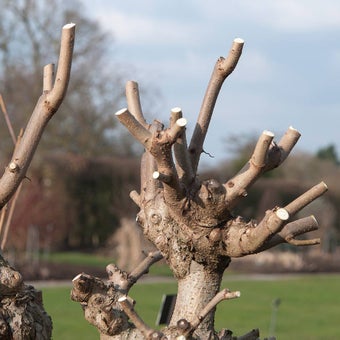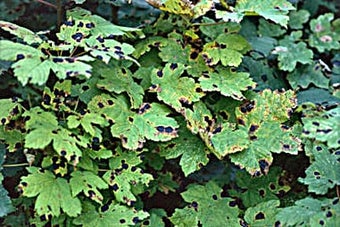
Quick facts
Common name - Plane anthracnose
Scientific name - Apiognomonia veneta
Plants affected - Plane trees, particularly Platanus occidentalis (American sycamore) and P. × hispanica (London plane)
Main symptoms - Twig and branch dieback. Death of young shoots shortly after they flush. Brown lesions on leaves, followed by premature leaf loss
Caused by - Fungus
Timing - Spring and early summer
What is plane anthracnose?
Plane anthracnose is a fungal disease affecting the leaves, twigs and branches of some species of plane tree. It varies in severity from year to year, and within a given year the degree to which the various symptom types develop also varies, according to wetness and temperature.
American sycamore (Platanus occidentalis) is most susceptible to the disease, whereas oriental plane (P. orientalis) is quite resistant. London plane (P. × hispanica) exists as a number of different , which vary in their susceptibility.
Symptoms
Planes can be big trees to monitor but watch for the tell-tale signs of plane anthracnose;
- Young leaves and shoots may die back in spring, making the tree look as though it has suffered from frost damage (this is known as ‘shoot blight’)
- may fail to open at all, sometimes on entire twigs or branches (‘ blight’)
- Leaves develop patches of dead tissue, most characteristically surrounding some of the main leaf veins (‘leaf blight’)
- Affected leaves frequently fall prematurely, often whilst they are still predominantly green. Severely affected trees can shed the majority of their leaves by early summer
- Twigs may be killed, and cankers may develop on larger branches (‘twig blight’)
- Even severely affected trees usually recover to produce new growth by mid-summer. However, the overall vigour of the tree can be reduced, and branch growth may become distorted if there is regular dieback
Control
Non-chemical control
- Sweep up and burn fallen leaves if this is practicable
- On young, small trees it may be possible to prune out affected twigs or branches
Resistance: Some cultivars of London plane are believed to have better anthracnose resistance than others. These include ‘Bloodgood’, ‘Columbia’ and ‘Liberty’. Unfortunately, these cultivars are not readily available.
Chemical control
There are no fungicides available to gardeners for use against plane anthracnose.
Biology
Plane anthracnose is caused by the fungus Apiognomonia veneta. The fungus produces rain-splashed spores from tiny fruiting bodies formed on affected twigs and leaves. Each of the symptom types is favoured by its own combination of weather conditions:
- Shoot blight usually develops after a period of cold spring weather, which slows the growth of the shoot and enables the fungus to colonise the shoot base
- Leaf blight requires a warm and wet spring, and is caused by spores splashed on to the leaves from dead twigs
- Twig blight and blight develop during warm spells in winter, whilst the tree is . The fungus can continue to grow at these times, killing the
The fungus becomes dormant in the twigs and branches during the summer months. At this time an affected tree often produces new shoots and leaves, which remain free from symptoms (particularly in hot, dry summers).







